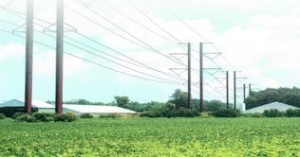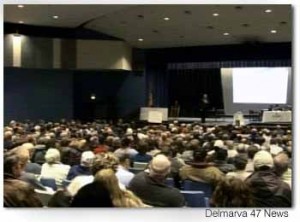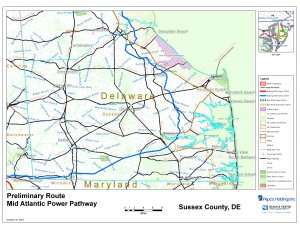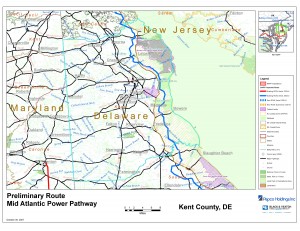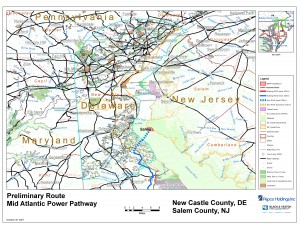600 show up for Delmarva Power transmission line meeting
February 6th, 2009
WOW! “Nearly 600” show up for a meeting about transmission. Good, Delmarva deserves that kind of response for their threat to ram the Mid-Atlantic Power Pathway transmission line through Maryland and Delaware to New Jersey. They’re so desperate that they’re threatening “rolling blackouts:”
More transmission lies. WDMT caught them making the same threats:
Delmarva Power Community and Communications Coordinator Matt Likovich said, “There have been projections that if we don’t do something to improve our infrastructure… we could be faced with rolling blackouts by the year 2011.”
Threatening rolling blackouts, saying that’ll happen by 2011, so we need to build this line by 2013… yeah… sure… whatever… Get a grip, guys, we are not that stupid, we’re not buying your threats — it is SO naughty to do that.
Power lines would relieve congestion
Putting the screws to coal
February 4th, 2009
Here’s the Executive Order — let’s have one in every state:
EXECUTIVE DIRECTIVE No. 2009 – 2
3. Generating or purchasing electricity from existing electricity generating resources.
This Directive is effective immediately.
Given under my hand this 3rd day of February in the year of our Lord, two thousand and nine.
Sussex Co. transmission meeting tonight
February 4th, 2009
Tonight is the final meeting in the group scheduled by Delmarva Power about the Mid-Atlantic Power Pathway, transmission through Delaware to New Jersey.
Wednesday, February 4 @ 6 p.m.
Millsboro Civic Center
322 Wilson Highway
Millsboro, Delaware
Sussex County:
Kent County:
New Castle County (cutout):
For more info on the underlying scheme, see my prior post:
In Grist today: Transmission Lies
February 3rd, 2009
Against the so-called ‘need’ for new long-distance, high-voltage transmission lines
Posted by Guest author (Guest Contributor) at 10:31 AM on 03 Feb 2009
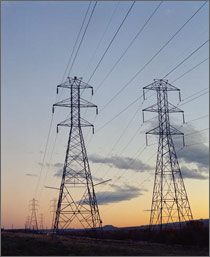
Transition … transmission … transition … transmission …
That old Bowie hook is on my mind as I represent individuals, community organizations, and local governments opposing high-voltage transmission lines. Today we’re at a crossroads in energy, a transition point where the decisions we make, like electricity itself, are binary. What we choose will determine how we use electricity in the future. The first step is to carefully define “need.”
Transmission doesn’t produce electricity. It is passive infrastructure that just sits there, conducting energy from one place to another. At its worst, though, it’s an enabler of dysfunctional energy planning and profit-driven projects that are against the public interest. Claims that we “need” transmission are end-stage conclusions of a many-step planning process that we as a society have not yet consciously begun.
“Need” is a term of art, and the crucial task for energy planners is to define the need. We need energy when we flick the switch, and when we do, that’s a utility’s need for service of local electrical load. We also need renewable generation, and we have an equally compelling need to reduce the CO2 emissions, pollutants, and toxic waste of electrical generation (a need not readily recognized in energy planning). Energy planners plan for peak “flick of the switch” need, those few very hot summer days or very cold winter nights. How much “flick of the switch” energy do we need? It depends.
Prior to assessing local load-serving need and making demand projections — before “need” is considered — the first and unarguably least-cost step is conservation. We can easily make up for an annual projected increase in demand of 1.5 percent through conservation, and can probably cut today’s “need” by 10 percent or more, though compound conservation gets more difficult as we cherry pick the easy stuff. The next step before analyzing need is to enact energy efficiency, demand-side management, and load-shifting to cut the peaks and level out the dips. This is also a comparatively least-cost means of meeting demand.
When that’s done, and not before, it’s time to assess our need for electricity — the supply side. Utilities, which are in the business of selling electricity and building their infrastructure — for which we pay, routinely promote sales and exaggerate growth in demand. Because of their overstatements of need in similarly recessionary times, we overbuilt in the 1970s, to the extent that many proposed plants were ultimately canceled. Still so much was built that we haven’t needed much utility infrastructure since. We’ve been through this before, and should be mindful in making investments.
Because of the recent utility industry shift to market-based dispatch, whereby generation is no longer strictly for service of local load but for wider regional or national electricity markets, market expansion has become the driver for the utility “need” for transmission. This is the key difference: how much transmission utilities need to serve their local load (the public good) vs. how much they need to participate in markets (greater profits). North American Electric Reliability Corporation (NERC), the private overseer of all things transmission, admits in Reliability Assessments that there is a lot of new electrical generation planned and that the transmission system is sufficient to meet local load-serving needs. The confounding factor: NERC notes that the transmission grid is constrained in places and is not sufficient for market purposes, for market expansion.
The short explanation of the shift to market focus is that, in theory, it makes generation available to all who want it, based on price rather than location. The cheapest is sold first, and buyers queue up in line. But the sale price is busbar price at the generator or seller, and does not take into account the costs of getting it from here to there — notably transmission construction, transmission service, and line loss. These costs are tacked on and billed to the purchasing utility, and will be added to the customer’s bill. The market “price” thus appears misleadingly low. Cheap coal-generated electricity from West Virginia looks awfully good to buyers in New Jersey when all the costs aren’t factored in to the sale price.
This is the crucial point: The divergence between traditional “local load-serving need” and the desire of utilities to beef up need claims, to build generation and transmission at ratepayer expense, in order play the market. State regulatory proceedings are couched in traditional “local load-serving need” terms, and utilities must prove up need before they are granted Certificates and proceed with construction. Investments must be “reasonable and prudent.” Opportunity to play the market is not reasonable and prudent, so it’s not a reason to build a transmission line — utility desire to increase market transactions is not recognized as “need” in a Certificate of Need or Certificate of Public Convenience and Necessity proceeding. This is where transmission lines become transmission lies: Transmission projects for market trading are couched in terms recognized by regulators.
Planning for “peak load” is a transmission lie. Utilities have incentive to overstate “need” when they build for peaks. The higher the peak they build for (with peak occurring only several times annually), the deeper the off-peak valley and the more electricity they can sell on the market when generation is available but not “needed.” Conservation and peak-shaving is against their interest because it lowers peak and lessens the valley of market sales.
“We’ll have blackouts” and “we’re going to freeze in the dark” are transmission lies. A review of recent blackouts — the ones used to justify transmission projects — shows that they occurred during off-peak times where utilities were overloading the lines, pushing more electricity than the system could handle. Despite warnings that the system was at risk, operators did not cut back on loading. An industry report on one blackout during “light load condition and low cost Mid-Continent Area Power Pool (MAPP) generation,” while “there were high simultaneous exports,” concluded:
This event should not be filed away as just another close call. We need to recognize just how close we were to collapsing portions of the Eastern Interconnection and adjust operating guides and reporting practices to avoid recurrence. There are real limits to the transfer capability out of the MAPP region and those limits are interdependent. This event is an alarming representation of how the MAPP regional interconnected system is being operated at and even beyond its capabilities.1
Utility “forecasts” are a lie. Despite their propensity to overstate need, several utility CEOs recently admitted that use has decreased from 3-9 percent, and that future infrastructure projects should be reconsidered. If we’ve moved from 1.5-2 percent projected growth to 3-9 percent decrease — with no increase in sight — that 4.5-11 percent drop in forecasted demand will substantially alter projections for years to come. The longer that drop continues, the further out it will affect projections. Despite this change in use and extension of “need” out in time, utilities are holding on to outdated projections. They still want to build infrastructure based on inflated “need,” infrastructure that we will pay for — and pay them a percentage return on investment. If approved, utilities will cover costs and make a return whether it is needed or not.
“It’s for renewable generation” is a lie. The massive transmission infrastructure expansion proposed is not “for renewables” because transmission may not discriminate by generation type. Federal regulations prohibit discrimination among generators — it’s first come, first ready, first served. There are tens of thousands of megawatts of coal projects, with transmission studies complete or in progress, waiting for interconnection, and whatever generation is ready will be connected. Another side of this lie is when wind advocates support transmission, claiming “it’s for renewables,” and ignore the impacts of transmission on the communities it traverses. Rather than make this convoluted “it’s for renewables” claim, there’s a better way: if renewable energy mandates were directly linked with shut down of fossil generation, and if renewable generators were thoughtfully sited, both the electricity market and transmission infrastructure would be open and available.
“Long distance transmission” is a lie. Transmission is inherently inefficient over long distances. Transmission physics entails high levels of line loss, and the longer the line, the higher the line loss. To avoid this fact of physics, the electric industry has shifted its line loss analysis for new projects to a “system wide” loss, so the numbers look low. But consider actual numbers of megawatts of line loss, and look at “coal plant equivalents” to make up that loss — for every 500-600 MW of line loss, a coal plant or more would have to be built! Line losses are charged in Federal Energy Regulatory Commission rates, but this is not considered directly in the market transactions. Line loss is an afterthought add-on to the customer’s bill after transmission service is provided. Consider too the capital cost of transmission, starting at about $1.5 million per mile for 345kV lines and upward from there.
Utilities’ frame of “need” for “public purpose” is a lie. Most transmission regions of the country are now planning transmission expansion to make their markets workable — to be able, theoretically, to ship power across the country. For example, in the Midwest, it’s the Midwest Transmission Expansion Plan. In PJM on the east coast, it’s the Regional Transmission Expansion Plan. These plans are all market-based, but for those transmission projects in states that regulate transmission, they’ll couch “need” in terms recognized by the state to get the approvals they need.
For example, CapX 2020 in the Midwest is framed for Minnesota regulators as needed for “local load-serving,” “regional reliability,” and “generation interconnection” — despite being an obvious expansion for coal through Minnesota to points east. The Mid-Atlantic Power Pathway is framed as necessary to serve local load in the Delmarva peninsula, despite being an obvious pass-through from West Virginia coal to New Jersey, connecting major power plants for export to the Northeast. Utility framing of this market-based, profit-based purpose as public purpose “need” also serves as their basis for taking land through eminent domain, because a corporation’s private purpose is expressly prohibited as justification for a taking.
Will we fall for transmission lies? Is new transmission a public purpose, a public need, provision of an essential service for a utility’s service area? Or is it an industry grab for market opportunities and profits at the public’s expense?
In my years of practice, I’ve yet to see a transmission line actually meant for the “need” proposed. We must take a critical look at these projects’ claims, because we’re the ones who will pay, and the lines will go over our land. Odds are, it’s private-purpose infrastructure that commits us to 50 or more years of wrongheaded, inefficient, and polluting central-station generation.
Electricity is binary, as is our situation now — we’re at a point where we must choose our path.
(Special thanks to electrical engineers Art Hughes, David Blecker, and Rick Gonzalez for making me learn about losses, planning, need, and powerflows.)
—–
1 Nebraska Public Power District, Report on June 10-11, 1997 Disturbance. See also Northern MAPP/Northwestern Ontario Disturbance — June 25, 1998 — Final Report; NERC Investigation of August 14, 2003 blackout.
SD’s Sen. Thune sucks up to Big Stone II
February 3rd, 2009
Horses Ass Award for South Dakota’s Senator John Thune.
Has he no shame? Sen. John Thune fired off this letter to the EPA when it filed objections to the Big Stone II air permit. Whatever is he thinking? That the regulations don’t apply to his pet project, despite the obvious emissions problems?
Here’s the letter:
It has recently come to my attention that the Environmental Protection Agency (EPA) has issued some objections regarding the South Dakota Department of Environment and Natural Resources (DENR) desire to renew the operating permit for the existing Big Stone Power Plant in South Dakota. As a strong proponent of expanding our commitment to addressing our nation’s energy challenges, I am writing to inquire about your Agency’s recent action, as well as how this objection impacts the Big Stone II project.
As you know, the United States is the world’s largest electricity consumer and is expected to remain that way for decades to come. In the Upper Midwest, experts predict several thousand megawatts of generation capacity are needed to meet our region’s growing energy demands. In responding to this challenge, five electric utilities have proposed building a 500-580-megawatt, coal-fired electric generation plant. The new facility would be built next to the existing 450-megawatt Big Stone Power Plant, located near Big Stone City, South Dakota. Four of these partners (Otter Tail Power Company, Heartland Consumers Power District, Montana-Dakota Utilities Company and Missouri River Energy Services) provide electricity to thousands of my constituents throughout South Dakota, and more than one million people when you total their services to individuals and businesses in four other states.
While the addition of Big Stone II will more than double the plant’s generation capacity, it will also utilize new technologies so that emissions of sulfur dioxide, nitrogen oxides and mercury from the two plants will be cleaner than the current, single plant. Big Stone II is also expected to emit 20 percent less carbon dioxide than existing coal-fired power plants in the region. Since President Obama indicated his readiness to “invest in low emissions coal plants” within his New Energy for America plan, I trust the Administration will support the efforts of these dedicated individuals who have committed their work, time and money on this project to ensure the region will have safe, reliable and affordable energy in the future.
This project is also crucial to our region’s increased commitment to wind energy development. As a United States Senator, I have endeavored to promote the advancement of wind energy in order to grow South Dakota’s economy and help meet our nation’s growing energy demands. One significant impediment to increasing wind energy production is the lack of transmission lines available to transfer this harnessed product to markets in need. Transmission upgrades that coincide with the construction of Big Stone II will also provide opportunities for the expansion of renewable wind energy in the region.
While I appreciate that permitting procedures under the Clean Air Act can be very complex, I understand that the South Dakota DENR has 90 days to submit a revised permit that meets the objections raised by your Agency. I am confident that the participating utilities and DENR will provide sufficient adjustments to the permit so the project is completed in an environmentally responsible manner that provides the electrical power essential to the region. Despite the claims by some advocacy groups, I sincerely hope the last-minute list of objections by EPA is not an attempt to derail this important and needed project.
I believe there is great potential in this undertaking by the five participating utilities. I look forward to hearing about your Agency’s role in moving this project forward, as it is essential to promoting economic growth and meeting the region’s energy demands, including expanded wind generation.
Kindest regards,
John Thune
United States Senator
